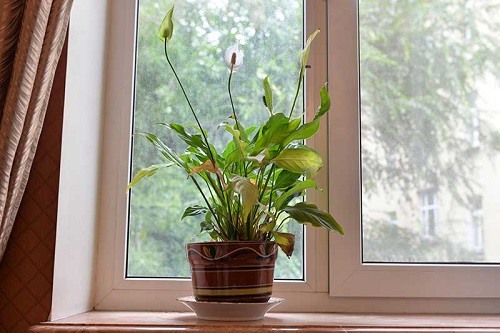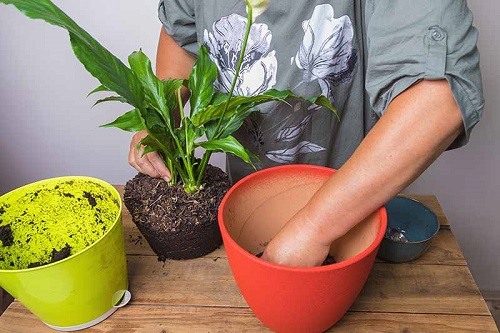Healthy peace lilies have elegant green foliages with stalks bearing lovely, slender, and graceful flowers. If you notice your peace lilies getting brown tips, it is time to review your maintenance and care routines.
So, why does my peace lily have brown tips? Brown tips on a peace lily plant are due to moisture stress, extreme temperatures, lack of humidity, direct sunlight exposure, plant diseases, and over-fertilization.
Identifying the causes of brown leaf tips on peace lilies may sound simple, but you need to learn a thing or two before fixing the issue. We wrote this article to provide comprehensive tips for treating brown tips on peace lily leaves. Let us find that out together now:

Reasons for Peace Lily Brown Leaf Tips
Multiple factors can make peace lily leaf tips turn brown. Let us now look at the top reasons for brown leaf tips on peace lilies and techniques for restoring the plant on track: (Source: Clemson Cooperative Extension)
Overwatering Problem
Overwatering is the leading cause of brown leaf tips on peace lilies. Houseplants that receive too much water cannot meet their oxygen requirements. The oversaturated potting soil usually inhibits the roots from absorbing oxygen.
Brown leaf tips are signs of peace lily’s roots suffocation since the excess water is known for sealing all the air spaces in the soil. The issue results in poor air circulation around the root system and potting soil.
Overwatering can also occur when the peace lily is grown in a large container. The extra-large pot holds adequate water that drains slowly while making the roots sit in the soggy soil for an extended period.
The brown leaf tips on peace lilies are due to a root-rot problem. The damaged roots become unable to absorb vital nutrients and water for the plant. Failure to fix the root-rot issue on time, peace lily plant will perish.
We recommend testing the soil moisture before watering your peace lily plant. A soil moisture meter is the most reliable instrument for testing potting soil moisture content. Irrigate your houseplant if the meter indicates the soil is on the dry side.
Re-pot your peace lily plant to a smaller container if it is challenging to maintain the appropriate moisture level. Small pots are known for draining water faster to reduce the risk of a root-rot problem.
Inconsistent Watering Habits
Under-watering is another cause of brown leaf tips on peace lilies. Roots need an optimum water supply to support the leaves above the soil. Inconsistent watering habits will force the plant to become dehydrated in the long run.
Dry and crispy leaf tips are indicators of inadequate water supply to the plant. You’ll also see the plant drooping and wilting along with brown leaf tips. Fixing browning peace lily tips due to under-watering is a no-brainer task.
We recommend testing the moisture content of the soil and adding water when it feels dry. Soil hydration will help bring your elegant peace lily leaves back on track. If you feel the potting soil is drying out quickly, add rice hulls into the medium.
Peace lilies consume more watering during spring and summer due to the active growth rate. We recommend watering the plant twice or thrice a week. But be sure to reduce the watering frequency in winter due to the dormancy effect.
Poor Soil Drainage
Potted peace lilies thrive in a fertile and well-draining potting soil. Poor drainage soil will lead to waterlogging and sogginess after watering. Oversaturated soil experiences poor aeration that causes brown leaf tips on peace lilies.
Poor drainage is also the leading cause of overwatering problems among houseplants. The issue occurs due to a lack of drainage holes that help get rid of excess water around the root systems causing brown leaf tips on peace lilies due to the root-rot effects.
We recommend growing your peace lilies in well-draining soil and a container with several drainage holes at the bottom. These holes will prevent water from accumulating at the bottom of the pot and soil sogginess.
Remember to develop the habit of re-potting peace lilies every two years to avoid root-bound issues. The problem usually makes the potting soil compact and inhibits proper water drainage around the plant.
Improper Watering Technique
Watering your peace lilies from the top will splash water droplets on the leaves leading to bacterial or fungal growth. These plant diseases are responsible for the brown peace lily leaf tips and edges.
We recommend watering your peace lilies from the bottom rather than the top since it helps prevent wetting the leaves’ surfaces. Self-watering planters are the best pots for keeping your houseplant hydrated without causing problems.
Extreme Temperatures
Peace lilies require a specific temperature range to thrive and survive. These houseplants are beginner friendly since they are not fussy. But brown leaf tips will occur when the indoor temperature is above 85oF and below 65oF.
We recommend keeping the houseplant away from heat vents to prevent the soil and foliages from drying out quickly. Besides that, move the plant away from the windows or doorways during the winter season.
Lack of Humidity
Peace lilies are tropical evergreen plants that thrive in a warm and humid environment. Every houseplant enthusiast needs to replicate the rainforest condition at home to help the peace lily plant flourish.
Low indoor humidity will make the leaf tips and edges turn brown and crispy. The leaf problem occurs since they experience faster water loss from leaves than absorption by the root systems.
We recommend moving the houseplant to the bathroom to enjoy the warmth and moisture from the daily shower. Another excellent option is to group the houseplants to help increase the humidity amount.
You can also install an electric humidifier to boost indoor humidity levels and keep the plant foliages green and glossy. Remember to follow a strict watering routine to maintain high humidity around your peace lily plant.
Over-fertilization
Peace lilies thrive in fertile and well-draining soil, although they are not heavy feeders like other tropical houseplants. We recommend applying little fertilizer to enhance vegetative growth and lushness.
Too much fertilizer application will result in brown leaf tip formation due to excessive salt accumulation in the potting soil. Over-fertilization problems occur when using a full-strength liquid fertilizer.
Be sure to flush the potting soil every three months to leach the excess mineral salt. Besides that, always use a diluted liquid fertilizer to feed your peace lily every month during the spring and summer seasons.
We recommend not feeding your peace lilies during winter due to the dormancy effect. If you accidentally feed your houseplant, consider re-potting to a fresh potting mix and container. It is not advisable to flush the potting soil during the winter period to avoid overwatering issues.
Direct Sunlight Exposure
Peace lilies prefer bright indirect sunlight to thrive and stay healthy. Brown leaf tips and edges will occur when the plant is placed in bright direct sunlight. The entire leaf will eventually turn brown and crispy.
The best solution is to move the houseplant from the spot receiving bright direct sunlight. Ensure the window has curtains to reduce the sunlight intensity. We recommend using artificial lighting for those living in regions with longer summer seasons.

People Who Read This Also Read:
Conclusion
Healthy peace lilies have elegant green leaves and beautiful lily-like flowers. If you see brown tips on your peace lily leaves, you need to review your cultural care routine asap. Brown peace lily leaf tips are due to improper care regime.
The leading causes of brown peace lily leaf tips are moisture stress, direct sunlight exposure, extreme temperatures, and lack of humidity, over-fertilization, and mineralized water. We recommend investigating your houseplant to identify the exact cause.
If you have read up to this point, I can now assume that you have been battling with brown leaf tips and edges on your peace lily plant. We hope the information in this article will help you fix the problem and prevent future occurrences.
